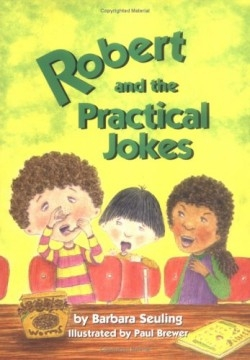
Robert and the Practical Jokes
Rubber snakes, toy mice, chocolate-covered worms—the trappings of a successful practical joke, right? Wrong! Third-grader Robert Dorfman’s teacher, Mrs. Bernthal, has had enough. The rubber-snake prank earns the class an extra homework assignment: “Write ten interesting facts about snakes,” igniting a war between the sexes. The girls blame the boys for frightening Melissa with the snake, forcing Mrs. Bernthal to take action, while the boys believe that Melissa simply overreacted. To make matters worse, someone releases a toy mouse, which causes Mrs. Bernthal to lose control of the class. The teacher knows there is only one way to stop her students. She assigns them a full research project, and not just any report: Robert’s entire class has to do research on “the weird and horrible.”
Robert does his report on werewolves, but Lucy’s report on exotic food is a mouthful. As the girls try chocolate-covered worms from Mexico, all of the boys decline, except Robert. “I told you we’d get even,” Lucy tells Robert, handing him the box of chocolate-covered worms—though she and the other girls only pretended to eat them. Just when Robert is about to believe that girls are horrible, Lucy teaches him how to catch a baseball, his mom teaches him to dance in time for his cousin’s wedding, and Lindsey teaches him how to fix his watch.
Though sometimes they lack cohesion, the twenty-one short chapters are just right for developing readers interested in chapter books. Robert’s problems and fears are realistic enough to capture the attention of the most reluctant readers, and make them want to cheer Robert on, especially when one of his practical jokes impresses his older brother, Charlie. Several authentic relationships, including the intergenerational friendship formed with Mrs. Santini when Robert’s class engages in service learning, offer warm and inviting depictions of Robert with family and friends. The black-and-white illustrations of Robert and Mrs. Santini—discussing the trouble he’s having with his watch and learning to dance—indicate that he is maturing and learning that it’s acceptable to ask for help. Humorous drawings show the boys’ delight and the girls’ horror when snakes and mice are turned loose in the class.
The author and illustrator have collaborated on several other books about Robert, such as Robert and the Great Pepperoni and Robert and the Weird & Wacky Facts. Seuling, who has also worked as an editorial assistant and a children’s book editor, is well known for How to Write a Children’s Book and Get It Published. Brewer collaborates with his wife Kathleen Krull, author of notable children’s biographies; he is also the author of You Must Be Joking!: Lots of Cool Jokes, Plus 17 ½ Tips for Remembering, Telling, and Making Up Your Own Jokes. Most of Brewer’s illustrations here are bound to have readers chuckling right along with Robert and his classmates.
Reviewed by
Kaavonia Hinton
Disclosure: This article is not an endorsement, but a review. The publisher of this book provided free copies of the book to have their book reviewed by a professional reviewer. No fee was paid by the publisher for this review. Foreword Reviews only recommends books that we love. Foreword Magazine, Inc. is disclosing this in accordance with the Federal Trade Commission’s 16 CFR, Part 255.
